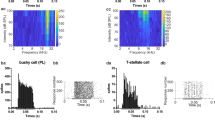Abstract
ELECTROMYOGRAPHIC, autonomic and electroencephalographic responses were recorded from human neonates during stimulation with sine and square wave tones and with human voices. This communication will concentrate on the analysis of the electromyograms, both because of their importance in reflecting behavioural changes, and because changes in autonomic activity, such as heart rate acceleration, are associated with movements. The “artificial” sounds were chosen so as to have certain structural similarities to the “biological” sound: they were either sine wave components of it or selected fundamentals with superimposed high frequencies. Sine wave and square wave tones of the following frequencies, rising by octaves, were selected: 125, 250, 500, 1,000 and 2,000 Hz. Further sine and square wave tones at 70 Hz were added because preliminary studies had suggested that responses to sound frequencies lower than 100 Hz may have especially interesting properties. Recordings of a male and of a female voice saying “baby” were also included.
This is a preview of subscription content, access via your institution
Access options
Subscribe to this journal
Receive 51 print issues and online access
$199.00 per year
only $3.90 per issue
Buy this article
- Purchase on Springer Link
- Instant access to full article PDF
Prices may be subject to local taxes which are calculated during checkout
Similar content being viewed by others
References
Prechtl, H. F. R., Akiyama, Y., Zinkin, P., and Kerr Grant, D., Dev. Med. Child Neurol. (in the press).
Prechtl, H. F. R., and Beintema, D., The Neurological Examination of the Full Term Newborn Infant (Heinemann, 1964).
Tukey, J. W., Biometrics, 5, 99 (1949).
Bast, T. H., and Anson, B. J., The Temporal Bone and the Ear (Thomas, Springfield, Illinois, 1949).
Anggard, L., Acta Oto-Laryngol., Suppl. 203 (1965).
Mikaelian, D. O., and Ruben, R. J., Arch. Otolaryngol., 80 (1964).
von Bekesy, G., in Neural Mechanisms of the Auditory and Vestibular Systems (edit. by Rasmussen, G. L., and Windle, W. F.) (Thomas, Springfield, Illinois, 1960).
Author information
Authors and Affiliations
Rights and permissions
About this article
Cite this article
HUTT, S., HUTT, C., LENARD, H. et al. Auditory Responsivity in the Human Neonate. Nature 218, 888–890 (1968). https://doi.org/10.1038/218888a0
Received:
Revised:
Published:
Issue Date:
DOI: https://doi.org/10.1038/218888a0
This article is cited by
-
Young autistic children's listening preferences in regard to speech: A possible characterization of the symptom of social withdrawal
Journal of Autism and Developmental Disorders (1991)
-
Neonates' vocal and facial expressions and their changes during experimental playbacks of intra-uterine sounds
Journal of Ethology (1989)
Comments
By submitting a comment you agree to abide by our Terms and Community Guidelines. If you find something abusive or that does not comply with our terms or guidelines please flag it as inappropriate.



